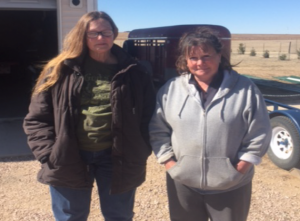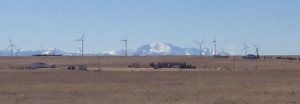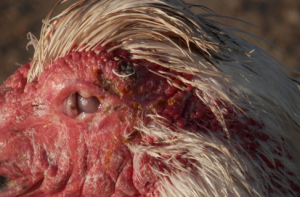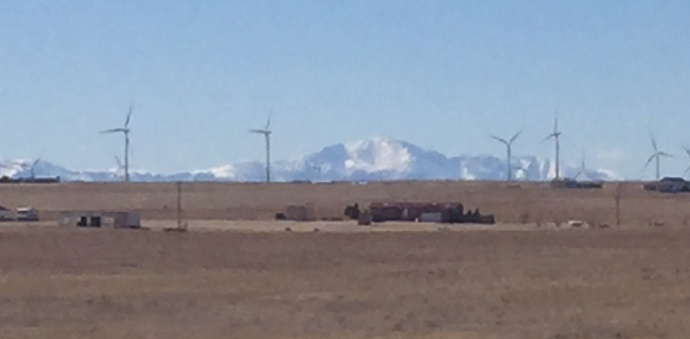By Kohl Watson with contributor Amy Cooke
Advocates of industrial wind espouse the benefits of “clean” and “free” energy. And yet, self-described environmentalists don’t acknowledge the human cost.
Since the Golden-West industrial wind farm in Calhan, Colorado began operating in late 2015, some residents of the quaint town have paid a physical and emotional price that gets little attention.
Calhan is a small town of less an thousand people, located about 45 minutes east of Colorado Springs. It has only one main road that runs through the town, and has a median income of a little less than $47,000, about $7,000 less than the state median income.
Sandra Wolfe and Cindy Cobb are residents of this small community. Cobb has lived in Calhan for 10 years with her husband, Joe. They breed dogs and miniature horses. Wolfe raises livestock as well, and was once a ballet dancer. Both of these women describe life in a the middle of an industrial wind farm as a nightmare.
 (Photo of Sandra Wolfe, left, and Cindy Cobb, right.)
(Photo of Sandra Wolfe, left, and Cindy Cobb, right.)
Wolfe once had a stunning view of the mountains, spanning the entire horizon from north to south. Now dozens of 425-foot, constantly spinning industrial turbines obstruct her view with some as close as 1350 feet from her home. Other property owners have complained about their compromised view too.
Some Colorado cities, including Denver, have “View Plane” ordinances, which protect citizen’s right to view the mountains by limiting building height and location[1]. Considering the El Paso County Board of County Commissioners permitted the industrial wind project, it’s safe to assume that neither Calhan nor El Paso County has the same type of protection.
 (Photo taken from Sandra Wolfe’s property)
(Photo taken from Sandra Wolfe’s property)
Besides a compromised view, both Cobb and Wolfe blame the turbines for deteriorating health. They report dizziness, nausea, loss of sleep and headaches. They say their symptoms coincide with when the wind farm became operational in September 2015.
Cobb adds lethargy and high blood pressure to the list of symptoms mentioned, and she fears for life, “I am here almost 24/7, 365 days. I have no break, and [I] fear living here is going to kill me.”
According to Wolfe, the relentless spinning causes stress and loss of sleep. She has resorted to sleeping off-site from her own property.
The symptoms aren’t unique to Cobb and Wolf. People in Maine, Ontario, and New Zealand have reported similar symptoms in connection to near by wind farms[2].
Both Cobb and Wolfe say the health impacts aren’t just limited to humans. Cobb reports, “We spent probably around $3,000 on vet bills, to have our vet look at the animals with issues, [such] as blindness, hoof issues, buying pain medications for the horses”.
Some of the claims include ducks going blind, cows that refuse to feed, donkeys with pituitary gland issues, deformities in newborn animals, and dogs developing mastitis[3]. Most disturbing is increase stillborn rates. Again, this claim is not unique to Cobb, Wolfe, and other Calhan residents. In 2014, a mink farm in Denmark experienced the miscarriage of over 1,600 baby minks after four wind turbines began operation only a year prior[4].
Wolfe reports that her cows have gone from producing 6 gallons of milk to only 1.5 in the year since the wind turbines, as well the deteriorating health of her dog. If humans are affected by the stress produced by the wind farm, their livestock and pets are even more vulnerable.

 (Above: Stillborn foal. Veterinarian could not determine cause of death, except for thickened placenta. Below: Duck, which has developed cataracts)
(Above: Stillborn foal. Veterinarian could not determine cause of death, except for thickened placenta. Below: Duck, which has developed cataracts)
Wolfe and Cobb believe that everyday they are forced to pay the cost for the Golden-West industrial wind farm. Visiting with them, their stress and anxiety is palpable. Following our meeting with these two women, Amy Cooke asked me if I could live here, under these relentlessly spinning turbines. “No,” was my answer.
Think you could live there with turning blades the size of jumbo jets and as high as a 50-story building? Listen and watch this video from Ontario first and then follow it up with this video. Bottom line, wind energy isn’t free. If you ask Cobb and Wolfe, the costs are quite high.
Kohl Watson and Amy Cooke visited Wolfe and Cobb in Calhan on March 2. This post is the first in a series about the Golden-West industrial wind farm. Next will be our report on sound levels and noise impacts that may be in violation of state law.
Harrison, Lindsey. “Wind farm: health controversy continues.” Windaction.org. December 7, 2015. Accessed March 12, 2017. http://www.windaction.org/posts/44988-wind-farm-health-controversy-continues#.WMYK51BtmHo.
“Windfarms: 1,600 miscarriages.” World Council for Nature. July 02, 2016. Accessed March 12, 2017. https://wcfn.org/2014/06/07/windfarms-1600-miscarriages/.
[1] http://denver-co.elaws.us/code/coor_titleii_ch10_artiv
[2] https://www.ncbi.nlm.nih.gov/pmc/articles/PMC3653647/
[3] Lindsey Harrison, “Wind farm: health controversy continues”, (New Falcon Herald, 2015)
[4] “Windfarms: 1600 miscarriages”, (wcfn.org, 2014).
Kohl Watson is a Future Leaders intern for the Energy Policy Center at the Independence Institute. Kohl previously served in the United States Army.








